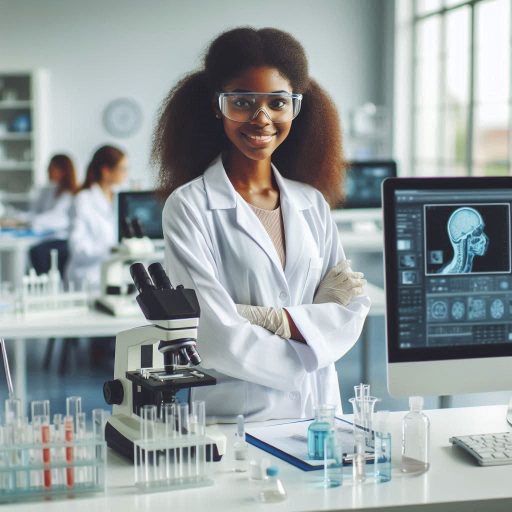Introduction
Biomedical engineering combines engineering principles with medical sciences to create innovative healthcare solutions.
This interdisciplinary field bridges the gap between technology and medicine, focusing on improving patient care through advanced technologies.
Biomedical engineers work on developing medical devices, diagnostic tools, and therapeutic systems.
Biomedical engineering projects are crucial for students for several reasons.
They offer hands-on experience, allowing students to apply theoretical knowledge to practical problems.
These projects develop technical skills, critical thinking, and problem-solving abilities.
Engaging in biomedical engineering projects fosters creativity and encourages students to think innovatively about healthcare solutions.
These projects prepare students for real-world challenges, equipping them with the necessary skills to succeed in the field.
Additionally, projects promote interdisciplinary learning, enabling students to work at the intersection of engineering, biology, and medicine.
The purpose of this blog post is to highlight the top biomedical engineering projects for students.
We aim to inspire students to explore and engage in these projects.
By participating, students can make significant contributions to medical advancements and enhance their future careers.
Non-invasive Glucose Monitoring System
Description of the Project
Developing a non-invasive glucose monitoring system involves creating a device that can measure blood glucose levels without needing traditional finger pricks.
This project aims to design a wearable device that continuously monitors glucose levels, providing real-time data to patients and healthcare providers.
The goal is to improve the quality of life for diabetic patients by offering a more comfortable and convenient way to manage their condition.
Benefits for Diabetic Patients
- Painless Monitoring: Eliminates the discomfort associated with frequent finger pricks, making glucose monitoring less invasive.
- Continuous Tracking: Provides real-time glucose levels, allowing patients to monitor their condition continuously throughout the day.
- Convenience: Enhances patient compliance by making glucose monitoring easier and more user-friendly.
- Better Management: Offers insights into glucose trends, helping patients and doctors make informed decisions about diet, medication, and lifestyle.
Technologies Involved
- Optical Sensors: These sensors use light to measure glucose levels in the blood. They detect changes in glucose concentration by analyzing how light is absorbed or scattered.
- Wearable Sensors: These devices can be integrated into smartwatches or patches that adhere to the skin, providing continuous glucose monitoring throughout the day.
- Data Analytics: Software tools analyze the collected data, identifying patterns and trends in glucose levels. This information can be used to make recommendations for managing diabetes.
- Bluetooth and Wi-Fi: Enable the device to communicate with smartphones and other devices, allowing easy access to data and remote monitoring by healthcare providers.
Potential Impact on Healthcare Industry
- Improved Patient Outcomes: Non-invasive monitoring enables better glucose management, reducing the risk of complications such as hypoglycemia and hyperglycemia.
- Cost Savings: Reduces the need for disposable test strips and frequent medical consultations, lowering overall healthcare costs.
- Innovation: Drives advancements in wearable health technologies, setting new standards in diabetes care and potentially benefiting other chronic conditions.
- Patient Empowerment: Empowers patients by providing them with the tools and information needed to take control of their health.
- Healthcare Accessibility: Makes glucose monitoring more accessible to a broader range of patients, including those who may avoid traditional methods due to pain or inconvenience.
In fact, the development of a non-invasive glucose monitoring system represents a significant advancement in diabetes care.
By leveraging optical sensors, wearable technology, and data analytics, this project can greatly improve the lives of diabetic patients and have a lasting impact on the healthcare industry.
Read: CAD Technician vs. Draftsman: Key Differences
Rehabilitation Robotic Exoskeleton
Overview of the Project
Developing a rehabilitation robotic exoskeleton aims to assist individuals with mobility impairments.
This innovative device helps users regain movement and strength.
It combines advanced technology with human biomechanics to support and enhance physical rehabilitation.
The project focuses on creating a wearable system that aids in walking and performing daily activities, improving the quality of life for individuals with limited mobility.
The Exoskeleton Assists Individuals
- Enhanced Mobility: Assists users in walking and performing daily activities, offering support where muscle strength is insufficient.
- Muscle Strengthening: Provides resistance and support to strengthen muscles during rehabilitation, promoting faster recovery.
- Improved Independence: Increases users’ ability to perform tasks independently, boosting confidence and autonomy.
- Posture Correction: Helps in maintaining proper posture, reducing the risk of further injuries and enhancing recovery.
Components of the Exoskeleton
- Sensors: Detect user movements and intentions, providing real-time feedback to the control system.
- Actuators: Provide the necessary force and movement to assist the user, mimicking natural muscle movements.
- Control Systems: Integrate sensor data to ensure smooth and responsive movement, adjusting to the user’s needs.
- Power Supply: Powers the exoskeleton for sustained use, ensuring reliability and efficiency.
- Feedback Mechanisms: Provide real-time data to both the user and healthcare providers, enabling continuous improvement and adjustment.
Future Applications in Physical Therapy
- Customized Rehabilitation: Tailors therapy to individual needs, enhancing recovery outcomes by focusing on specific muscle groups and movement patterns.
- Remote Therapy: Enables therapists to monitor and adjust treatment plans remotely, increasing accessibility to rehabilitation services.
- Enhanced Recovery: Improves the effectiveness of physical therapy, leading to quicker and more comprehensive recovery.
- Broader Accessibility: Makes advanced rehabilitation technology more accessible to a wider range of patients, including those in remote or underserved areas.
- Preventative Care: Can be used to prevent deterioration in patients with degenerative conditions by maintaining muscle activity and mobility.
In essence, the rehabilitation robotic exoskeleton represents a significant advancement in biomedical engineering.
By integrating sensors, actuators, and control systems, this project aims to enhance mobility and independence for individuals with mobility impairments.
Its potential applications in physical therapy can revolutionize rehabilitation, making it more effective and accessible.
This project not only aids in recovery but also improves the quality of life for countless individuals, demonstrating the profound impact of biomedical engineering on healthcare.
Read: CAD Technician Certification: What You Need to Know
Smart Prosthetic Limbs
Explanation of the Project
Smart prosthetic limbs represent a significant advancement in the field of biomedical engineering, utilizing cutting-edge technologies to create highly functional and responsive artificial limbs.
These prosthetics go beyond traditional designs by incorporating advanced sensors, actuators, and artificial intelligence to closely mimic natural limb movements.
The project involves integrating various technologies to enhance the user‘s mobility and dexterity.
Smart prosthetic limbs are equipped with sensors that detect muscle movements or neural signals, translating them into precise movements of the prosthetic.
This integration allows users to perform complex tasks with greater ease and accuracy, improving their overall quality of life.
Moreover, smart prosthetics often include adaptive features that adjust to different activities and environments, providing a more personalized experience.
This innovation not only enhances physical capabilities but also helps users regain confidence and independence in their daily lives.
Advantages of Smart Prosthetics Over Traditional Prosthetics
- Enhanced Movement: Smart prosthetics offer more natural and precise movement.
- User Comfort: Improved design reduces discomfort and fits better.
- Greater Control: Users experience better control through integrated technology.
Integration of Sensors and AI Technology for Improved Functionality
- Sensors: Detect muscle signals and user intentions.
- AI Technology: Interprets signals to control prosthetic movements smoothly.
- Real-Time Feedback: Adjusts movements for more natural functionality.
Testimonials from amputees using these limbs
- Amputees who have used smart prosthetic limbs report higher satisfaction levels compared to traditional prosthetics.
- Users appreciate the increased range of motion, comfort, and natural feel provided by smart prosthetic limbs.
- Many amputees have expressed gratitude for the improved quality of life and independence that smart prosthetic limbs have given them.
In short, smart prosthetic limbs represent a significant step forward in prosthetic technology, offering amputees greater functionality, comfort, and independence.
Read: Networking Tips for Aspiring Surgical Technologists

Biomedical Imaging Analysis Software
Details of the project
Biomedical imaging analysis software represents a significant advancement in medical diagnostics, focusing on enhancing the accuracy and efficiency of interpreting medical images.
This project involves the development of sophisticated tools that process and analyze medical images with greater precision.
By leveraging cutting-edge technologies, the software aims to transform how healthcare providers interpret imaging data, ultimately improving patient care and diagnostic outcomes.
Importance of Accurate and Efficient Imaging Analysis in Healthcare
Accurate and efficient imaging analysis is crucial in modern healthcare for several reasons.
Enhanced diagnostics lead to more accurate disease detection, which is vital for effective treatment planning.
Faster analysis reduces diagnostic delays, allowing healthcare providers to initiate treatments more promptly.
This efficiency not only speeds up patient care but also improves overall patient outcomes by ensuring that conditions are identified and managed as quickly as possible.
Effective imaging analysis also supports better disease management and ongoing patient monitoring, contributing to long-term health improvements.
Utilization of Machine Learning Algorithms for Diagnosis
Machine learning algorithms are integral to the functionality of biomedical imaging analysis software.
These algorithms excel in detecting patterns and anomalies within medical images, which might be challenging for human observers to identify.
Automated analysis through machine learning provides faster and more consistent results, significantly enhancing diagnostic efficiency.
The software also benefits from adaptive learning, where algorithms continuously improve their accuracy by processing more data and receiving feedback.
This dynamic learning process ensures that the software remains at the forefront of diagnostic technology, offering increasingly precise analyses over time.
Potential for Early Disease Detection
The potential for early disease detection with advanced imaging software is profound.
By identifying diseases at their earliest stages, the software enables prompt intervention, which can be crucial for effective treatment.
Early detection improves prognosis and increases the likelihood of successful outcomes by addressing health issues before they progress.
Moreover, the ability to detect conditions early supports preventive care strategies, allowing for proactive management of health issues and reducing the risk of severe complications.
This capability not only benefits individual patients but also enhances public health by promoting early and effective management of widespread health conditions.
Read: Common Challenges Faced by Surgical Technologists
3D Bioprinting for Tissue Engineering
Description of the project
3D bioprinting for tissue engineering is an innovative project that uses advanced 3D printing technology to create complex biological tissues.
This project centers around developing printable tissue structures with applications ranging from medical repair to research and training.
By enabling the creation of functional tissue constructs, 3D bioprinting holds significant promise for transforming regenerative medicine and improving patient care.
Significance of 3D Bioprinting in Regenerative Medicine
3D bioprinting plays a crucial role in regenerative medicine by offering several key benefits:
It facilitates the creation of complex tissue structures, which can repair or replace damaged tissues, enhancing the body’s ability to heal itself.
This technology allows for the customization of tissues based on individual patient needs, improving the compatibility and effectiveness of treatments.
It helps address the critical shortage of organ donors by providing potential solutions for creating viable tissue substitutes, thereby reducing wait times for transplants.
Transform Your Career Today
Unlock a personalized career strategy that drives real results. Get tailored advice and a roadmap designed just for you.
Start NowMaterials Used for Bioprinting Tissue Structures
The effectiveness of 3D bioprinting relies on a variety of specialized materials:
These inks consist of a mixture of cells, growth factors, and biomaterials designed to replicate the properties of natural tissues.
They are fundamental for creating viable tissue constructs.
Hydrogels act as a supportive environment for cell growth and tissue development, providing the necessary hydration and nutrients for cells to thrive.
These are used to create scaffolds that support and guide the formation of new tissues.
They provide structural integrity and help maintain the shape of the tissue as it develops.
Applications in Creating Organ Models for Surgical Training
3D bioprinting also has transformative applications in surgical training
- Realistic Simulations: The technology can produce highly accurate organ models, allowing for realistic simulations of surgical procedures. This aids in preparing surgeons for complex surgeries.
- Enhanced Training: It offers valuable hands-on experience without the risks associated with real surgeries, contributing to safer and more effective surgical practices.
- Improved Outcomes: By refining surgical skills and techniques through practice on realistic models, the technology leads to better patient care and improved surgical outcomes.
3D bioprinting for tissue engineering represents a major advancement in biomedical engineering.
By using biological inks, hydrogels, and synthetic polymers, this technology enhances tissue repair and provides realistic models for surgical training.
It holds significant potential for personalized medicine, improved patient outcomes, and the development of innovative medical solutions.
Overall, 3D bioprinting for tissue engineering represents a cutting-edge technology with immense potential to transform healthcare and personalized medicine.
Read: Preparing for a Sonography Job Interview: Tips
Neural Interface for Brain-Computer Interface
Overview of the project
Computer Interface (BCI) project is a pioneering initiative in the field of biomedical engineering.
This ambitious project aims to create a sophisticated system that facilitates direct communication between the brain and external devices.
By developing such an interface, researchers hope to bridge the gap between neural activity and digital technology, enabling users to control devices, computers, or prosthetics through thought alone.
The technology involves intricate processes to decode brain signals accurately and translate them into commands that external devices can understand and act upon.
The project leverages advanced techniques in neural signal processing, machine learning, and material science to create a seamless interface that can accurately interpret and respond to brain activity.
It requires overcoming numerous technical challenges, such as improving signal clarity, reducing noise, and ensuring biocompatibility with neural tissue.
Additionally, the system must be designed to offer high reliability and precision, making it practical for real-world applications.
How neural interfaces enable communication between the brain and external devices
Neural interfaces enable communication between the brain and external devices by translating electrical signals generated by neural activity into commands that computers or other devices can interpret.
The process begins with the capture of neural signals, often through electrodes placed on the scalp or implanted in the brain.
These electrodes detect the electrical activity produced by neurons firing in specific patterns.
Once captured, the raw signals are processed and decoded using sophisticated algorithms.
These algorithms analyze the patterns of electrical activity to identify the intended commands or actions.
The translated commands are then transmitted to external devices, allowing users to control them using their thoughts.
Challenges in developing reliable neural interfaces
Developing reliable neural interfaces presents several significant challenges, primarily involving the accuracy and reliability of translating brain signals.
The brain, being an extraordinarily complex organ, generates intricate neural patterns that are difficult to interpret.
Achieving high levels of precision requires overcoming issues such as signal noise, which can obscure meaningful data and hinder accurate interpretation.
The task of translating raw neural signals into actionable information demands sophisticated algorithms and processing techniques to ensure clarity and usefulness.
Additionally, the materials used in neural interfaces must be biocompatible, integrating well with brain tissue over the long term.
Ensuring the durability of these devices, while minimizing invasiveness, is crucial, as many current interfaces require procedures that pose risks to patients.
Developing non-invasive or minimally invasive alternatives is a key research area.
Ethical and privacy concerns also play a significant role, including protecting neural data and addressing potential misuse.
Overcoming these challenges is essential for advancing neural interface technology and ensuring its safety and effectiveness.
Medical and research applications in neuroscience
The development of neural interfaces has vast implications in the field of neuroscience.
These interfaces can be used to study brain function, treat neurological disorders, and even enhance cognitive abilities in individuals.
Neural interfaces have the potential to revolutionize the way we interact with technology and understand the complexities of the human brain.
By bridging the gap between the brain and external devices, these interfaces open up a world of possibilities for individuals with disabilities and researchers alike.
Find Out More: Salary Expectations for Chemical Engineers
Artificial Intelligence in Healthcare Diagnostics
Explanation of the project
Artificial Intelligence (AI) has revolutionized the field of healthcare diagnostics by enhancing both the accuracy and efficiency of medical data analysis.
This project focuses on utilizing AI algorithms to refine and improve diagnostic practices in healthcare settings.
AI plays a pivotal role in analyzing complex medical data.
It automates the examination of extensive datasets, such as medical images and pathology results, leading to more precise diagnostic outcomes.
For example, Convolutional Neural Networks (CNNs) are widely used to analyze medical imaging, including X-rays, MRIs, and CT scans.
These algorithms excel at detecting intricate patterns and abnormalities that may be missed by human eyes.
In pathology, AI employs deep learning models to identify cancerous cells and other significant features in tissue samples.
This process not only enhances diagnostic accuracy but also accelerates the analysis, reducing the time required to reach a diagnosis.
Role of AI in Analyzing Medical Data for Diagnosis
AI plays a crucial role in processing large volumes of medical data quickly and accurately.
By leveraging advanced algorithms, AI systems can efficiently analyze complex datasets that include medical imaging, pathology results, and patient records.
This capability allows AI to identify patterns, trends, and anomalies in the data that may not be readily apparent to human observers.
For instance, AI algorithms can detect subtle changes in medical images, such as X-rays or MRIs, which might indicate early stages of diseases.
These patterns are often missed by the human eye, but AI’s ability to process and interpret vast amounts of data enables more precise diagnostics.
Similarly, in pathology, AI can analyze tissue samples to recognize cancerous cells and other abnormalities with a high degree of accuracy.
By automating and enhancing the analysis process, AI enables healthcare providers to diagnose diseases more efficiently and effectively.
This leads to faster decision-making and potentially better outcomes for patients.
Examples of AI Algorithms Used in Medical Imaging and Pathology
AI algorithms such as machine learning, deep learning, and neural networks are widely used in medical imaging and pathology to enhance diagnostic accuracy.
These advanced techniques leverage large datasets to improve the detection and analysis of medical conditions.
Convolutional Neural Networks (CNNs) are particularly effective in analyzing medical images interpret complex visual data, making them invaluable for detecting abnormalities or tumors in X-rays, MRI sand structures within the images, CNNs can identify potential issues with high precision.
Deep Learning Models extend this capability by learning from vast amounts of data to improve their accuracy over time. In pathology, deep learning algorithms analyze tissue samples to detect cancerous cells and other anomalies.
Machine Learning Techniques These algorithms can process diverse types of medical data, from lab results to electronic health records, helping to identify trends and risk factors associated with various conditions.
Potential for Improving Accuracy and Efficiency in Healthcare Diagnostics
Leveraging AI technology has the potential to revolutionize healthcare diagnostics by significantly enhancing both accuracy and efficiency.
AI algorithms can process vast amounts of data in real-time, allowing for more precise and timely diagnoses.
By analyzing medical images, pathology results, and patient records with high accuracy, AI systems can identify subtle patterns and anomalies that might be missed by human observers.
This capability leads to more accurate diagnoses and better-informed treatment recommendations, ultimately improving patient outcomes.
For example, AI-driven tools can quickly detect early signs of diseases, allowing for earlier intervention and more effective treatment.
The speed and precision of AI also reduce the likelihood of diagnostic errors, enhancing overall healthcare quality.
Conclusion
Biomedical engineering projects are essential for students as they foster innovation and provide valuable hands-on experience in the field.
Engaging in these projects helps students bridge the gap between theory and practice, applying their academic knowledge to real-world challenges.
By tackling complex issues such as improving diagnostic accuracy, developing advanced prosthetics, or creating innovative tissue engineering solutions, students play a pivotal role in advancing medical technology.
These projects not only enhance students’ practical skills but also ignite their creativity and problem-solving abilities.
They offer a platform to explore cutting-edge technologies and contribute to meaningful advancements in healthcare.
We strongly encourage students to actively explore and immerse themselves in these innovative projects.
Taking part in biomedical engineering projects allows students to make a tangible impact on patient care and medical practices.
Aspiring biomedical engineers should seize these opportunities to shape the future of healthcare.
Your involvement can drive significant improvements in medical technology and patient outcomes.
Embrace the challenge, contribute your expertise, and be at the forefront of transforming the healthcare industry through groundbreaking project development.




